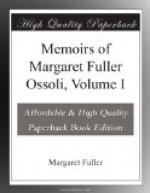* * * * *
But if she studied books thus earnestly, still more frequently did she turn to the study of men. Authors and their personages were not ideal beings merely, but full of human blood and life. So living men and women were idealized again, and transfigured by her rapid fancy,—every trait intensified, developed, ennobled. Lessing says that “The true portrait painter will paint his subject, flattering him as art ought to flatter,—painting the face not as it actually is, but as creation designed, omitting the imperfections arising from the resistance of the material worked in.” Margaret’s portrait-painting intellect treated persons in this way. She saw them as God designed them,—omitting the loss from wear and tear, from false position, from friction of untoward circumstances. If we may be permitted to take a somewhat transcendental distinction, she saw them not as they actually were, but as they really were. This accounts for her high estimate of her friends,—too high, too flattering, indeed, but justified to her mind by her knowledge of their interior capabilities.
* * * * *
The following extract illustrates her power, even at the age of nineteen, of comprehending the relations of two things lying far apart from each other, and of rising to a point of view which could overlook both:—
’I have had,—while staying a day or two in Boston,—some of Shirley’s, Ford’s, and Hey wood’s plays from the Athenaeum. There are some noble strains of proud rage, and intellectual, but most poetical, all-absorbing, passion. One of the finest fictions I recollect in those specimens of the Italian novelists,—which you, I think, read when I did,—noble, where it illustrated the Italian national spirit, is ruined by the English novelist, who has transplanted it to an uncongenial soil; yet he has given it beauties which an Italian eye could not see, by investing the actors with deep, continuing, truly English affections.’
* * * * *
The following criticism on some of the dialogues of Plato, (dated June 3d, 1833,) in a letter returning the book, illustrates her downright way of asking world-revered authors to accept the test of plain common sense. As a finished or deliberate opinion, it ought not to be read; for it was not intended as such, but as a first impression hastily sketched. But read it as an illustration of the method in which her mind worked, and you will see that she meets the great Plato modestly, but boldly, on human ground, asking him for satisfactory proof of all that he says, and treating him as a human being, speaking to human beings.




